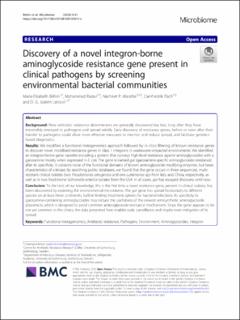| dc.description.abstract | Background
New antibiotic resistance determinants are generally discovered too late, long after they have irreversibly emerged in pathogens and spread widely. Early discovery of resistance genes, before or soon after their transfer to pathogens could allow more effective measures to monitor and reduce spread, and facilitate genetics-based diagnostics.
Results
We modified a functional metagenomics approach followed by in silico filtering of known resistance genes to discover novel, mobilised resistance genes in class 1 integrons in wastewater-impacted environments. We identified an integron-borne gene cassette encoding a protein that conveys high-level resistance against aminoglycosides with a garosamine moiety when expressed in E. coli. The gene is named gar (garosamine-specific aminoglycoside resistance) after its specificity. It contains none of the functional domains of known aminoglycoside modifying enzymes, but bears characteristics of a kinase. By searching public databases, we found that the gene occurs in three sequenced, multi-resistant clinical isolates (two Pseudomonas aeruginosa and one Luteimonas sp.) from Italy and China, respectively, as well as in two food-borne Salmonella enterica isolates from the USA. In all cases, gar has escaped discovery until now.
Conclusion
To the best of our knowledge, this is the first time a novel resistance gene, present in clinical isolates, has been discovered by exploring the environmental microbiome. The gar gene has spread horizontally to different species on at least three continents, further limiting treatment options for bacterial infections. Its specificity to garosamine-containing aminoglycosides may reduce the usefulness of the newest semisynthetic aminoglycoside plazomicin, which is designed to avoid common aminoglycoside resistance mechanisms. Since the gene appears to be not yet common in the clinics, the data presented here enables early surveillance and maybe even mitigation of its spread. | en_US |
